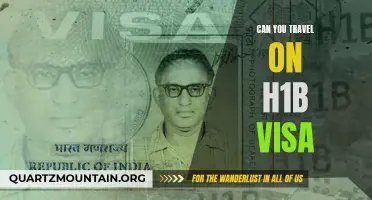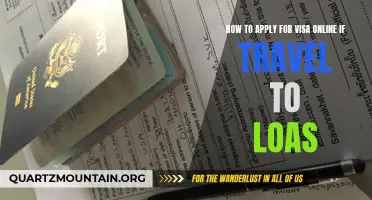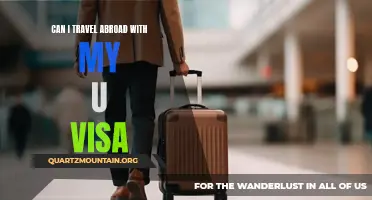
Obtaining a US visa and traveling to the United States can be an exciting and challenging experience. Whether you are planning a vacation, pursuing higher education, or exploring work opportunities, navigating through the visa application process can sometimes feel overwhelming. However, fear not! In this guide, we will provide you with valuable tips to help you successfully obtain a US visa and make your journey to the land of dreams a smooth and enjoyable one. So, if you're ready to embark on your American adventure, keep on reading!
What You'll Learn

Visa requirements for traveling to the US
Traveling to the United States can be an exciting and rewarding experience. However, before you can embark on your journey, you need to make sure you have the necessary visa. The visa requirements for traveling to the US can be complex, but with the right information and preparation, you can ensure a smooth and successful application process. Here is a step-by-step guide on how to obtain a visa for traveling to the US:
Determine the type of visa you need:
There are different types of visas depending on the purpose of your visit, such as tourist visas, business visas, student visas, and work visas. It's essential to know which visa category applies to your situation, as the application process and requirements may vary.
Research visa requirements:
Once you know the type of visa you need, research the specific requirements for that visa category. Visit the official website of the U.S. Department of State to find detailed information about the required documents, fees, and application process. Make sure to read and understand all the instructions carefully to avoid any mistakes or delays.
Complete the online application form:
Most visa applications for traveling to the US are submitted online. Begin by filling out the DS-160 form, which can be accessed on the U.S. Department of State's website. Provide accurate and complete information, as any inaccuracies or omissions may result in the denial of your visa application.
Pay the visa application fee:
Along with the application form, you will need to pay a non-refundable visa application fee. The fee amount varies depending on the type of visa you are applying for. Payment options and instructions can be found on the U.S. Department of State's website.
Schedule a visa interview:
In most cases, you will be required to attend a visa interview at a U.S. embassy or consulate in your home country. Go to the website of the U.S. embassy or consulate nearest to you and schedule an appointment for the visa interview. It is advisable to schedule your interview well in advance, as appointment availability can be limited.
Gather the required documents:
Before your interview, gather all the necessary documents as outlined in the visa application requirements. This may include your passport, previous travel documents, proof of ties to your home country, financial statements, and a letter of invitation or employment verification, depending on the purpose of your visit. Ensure that all your documents are up to date and in the required format.
Attend the visa interview:
On the day of your visa interview, arrive early and dress appropriately. Be prepared to answer questions regarding the purpose of your visit, your travel plans, and ties to your home country. The consular officer will review your application and supporting documents and may ask additional questions if necessary. Be honest and provide concise and clear answers.
Await the visa decision:
After the interview, the consular officer will inform you of the visa decision. If approved, your passport with the visa will be returned to you by mail or courier service. If the visa is denied, the officer will provide you with an explanation for the rejection. In case of refusal, you may have the option to reapply if the issue can be addressed.
Prepare for your trip:
Once you have obtained your visa, start making travel arrangements for your trip to the United States. Ensure that your passport is valid for at least six months beyond the planned duration of your stay. Make sure to understand the entry requirements and any border procedures for the U.S. to avoid any difficulties upon arrival.
It is crucial to begin the visa application process well in advance of your planned travel dates, as processing times may vary. Following these steps will help you navigate through the visa requirements for traveling to the US successfully. Remember to carefully review all the instructions, gather all required documents, and be well-prepared for the visa interview. With proper planning and organization, you can make your travel to the United States a memorable experience.
Exploring Paris with an Expired US Visa: Is It Possible?
You may want to see also

Step-by-step guide to applying for a US visa
Are you planning to visit the United States? If so, you will likely need a visa to enter the country. The U.S. visa application process can be complex, but with the right information and preparation, it can be a relatively straightforward process. In this step-by-step guide, we will walk you through the entire process of applying for a U.S. visa.
Step 1: Determine the type of visa you need
The United States offers several types of visas, including tourist visas, work visas, student visas, and more. The type of visa you need will depend on the purpose of your visit. Visit the U.S. Department of State's website to find the visa category that best suits your needs.
Step 2: Complete the online application form
Once you have determined the type of visa you need, you will need to complete the online application form (DS-160) on the U.S. Department of State's website. This form will require you to provide your personal information, travel details, and other relevant information. Make sure to review the form carefully and provide accurate and complete information.
Step 3: Pay the visa application fee
After completing the online application form, you will be required to pay the visa application fee. The fee amount will depend on the type of visa you are applying for. You can pay the fee online or at a designated payment center. Keep in mind that the fee is non-refundable, even if your visa application is denied.
Step 4: Schedule an appointment at the U.S. Embassy or Consulate
Once you have paid the visa application fee, you will need to schedule an appointment at the U.S. Embassy or Consulate in your country of residence. You can schedule an appointment online or by contacting the embassy or consulate directly. It is advisable to schedule your appointment well in advance, as the wait times can vary.
Step 5: Gather the required documents
Before your visa interview, you will need to gather the required documents. These may include your passport, a passport-sized photograph, proof of your intent to return to your home country, financial documents, and any other supporting documents that are relevant to your visa application. Make sure to review the specific document requirements on the U.S. Department of State's website.
Step 6: Attend the visa interview
On the day of your visa interview, make sure to arrive at the U.S. Embassy or Consulate on time. The interview is a crucial part of the visa application process, as it allows the consular officer to determine whether you are eligible for a visa. Be prepared to answer questions about your travel plans, the purpose of your visit, and your ties to your home country. It is important to be honest and provide clear and concise answers.
Step 7: Wait for a decision
After your visa interview, you will need to wait for a decision on your visa application. The time it takes to process a visa application can vary, so it is important to be patient. You can check the status of your application online, but keep in mind that this information may not be available immediately.
Step 8: Collect your visa
If your visa application is approved, you will be notified to collect your visa. You may need to provide additional documents or pay a visa issuance fee before receiving your visa. Make sure to carefully review the instructions provided by the U.S. Embassy or Consulate.
Step 9: Prepare for your trip
Before traveling to the United States, make sure to prepare for your trip. This may include making travel arrangements, booking accommodations, and obtaining any necessary travel insurance. It is also important to familiarize yourself with U.S. entry requirements and customs regulations.
Applying for a U.S. visa can be a time-consuming process, but by following these steps and being well-prepared, you can increase your chances of success. Remember to review the specific requirements for your visa category and provide accurate and complete information. Good luck with your visa application and enjoy your trip to the United States!
Exploring the Flexibility of Travel for H4 Visa Holders
You may want to see also

Tips for a successful US visa interview
Getting a US visa can be an intimidating process, but with the right preparation, you can increase your chances of success. One of the most critical steps in this journey is the visa interview, where you will be asked questions about your background and purpose of travel to the United States. To help you succeed in your visa interview, here are some tips to keep in mind:
- Know your purpose of travel: Before attending the visa interview, make sure you have a clear understanding of your purpose of travel to the US. Whether it's for tourism, business, education, or any other reason, be prepared to explain it to the visa officer. It's essential to demonstrate that your intent aligns with the visa category you are applying for.
- Gather your documents: Compile all the necessary supporting documents to carry with you to the interview. This may include your passport, visa application confirmation, financial and employment records, educational certificates, and any additional documents required based on your visa category. Organize them in a systematic manner, making it easy for you to present them if requested.
- Dress appropriately: Dress professionally and conservatively for your visa interview. Your appearance can create an impression on the visa officer, so it's best to avoid casual clothing. Opt for formal attire that portrays you as serious and responsible. Remember, first impressions matter.
- Be honest and concise: During the interview, answer questions truthfully and concisely. The visa officer will be evaluating the consistency of your responses and looking for any signs of fraud. Avoid providing extra information that was not asked, as it may complicate your case unnecessarily. Stick to the facts and keep your answers straightforward.
- Practice common interview questions: Familiarize yourself with common visa interview questions and practice answering them beforehand. Questions may revolve around your travel plans, ties to your home country, financial stability, and other personal details. By rehearsing your answers, you can improve your confidence and respond more effectively during the actual interview.
- Be confident and respectful: Maintain a confident and polite demeanor throughout the visa interview. Make eye contact with the visa officer and speak clearly. Avoid interrupting the officer while they are speaking, and always remain courteous. Showing respect can leave a positive impression on the interviewer.
- Demonstrate strong ties to your home country: The visa officer will want to assess whether you have sufficient ties to your home country that will motivate you to return after your US visit. These ties can include family, property, employment, or any other commitments. Provide evidence of your strong ties to demonstrate that you have reasons to come back.
- Stay calm and composed: Nervousness is natural during a visa interview, but try your best to stay calm and composed. Take deep breaths and focus on providing clear answers. Remember that your demeanor can influence the visa officer's perception of you, so try to project confidence despite any nerves.
- Be prepared for potential additional questions: Depending on your case, the visa officer may have further questions or request additional documents. Stay prepared for such a scenario, as it does not necessarily indicate a negative outcome. Cooperate and provide the requested information promptly.
- Follow up if necessary: If your visa is approved, congratulations! If not, you will be informed of the reason for denial. If you believe there may have been a misunderstanding or an error, you can consult an immigration lawyer for guidance and explore your options.
Remember, success in a visa interview largely depends on your preparedness, honesty, and ability to demonstrate strong ties to your home country. By following these tips and approaching the interview with confidence, you can increase your chances of a successful visa application.
How to Apply for an Agriculture Visa to Travel to Cuba
You may want to see also

Important documents to bring when traveling with a US visa
When traveling to the United States with a US visa, it is important to have all the necessary documents to ensure a smooth and hassle-free journey. Here are some important documents to bring with you:
- Valid Passport: Your passport is the most essential document you will need when traveling. Make sure your passport is valid for at least six months beyond your intended stay in the United States.
- Valid US Visa: Your US visa is a stamp or sticker placed on your passport that allows you to enter the United States. Ensure that your visa is still valid and matches the purpose of your visit.
- DS-160 Confirmation Page: The DS-160 is an online nonimmigrant visa application form that you need to complete before scheduling a visa interview. After submitting the form, you will receive a confirmation page, which you should print and bring with you.
- Visa Interview Appointment Letter: This is a letter confirming the date, time, and location of your visa interview. Keep a copy of this letter with you when traveling.
- I-20 or DS-2019 Form (for F or J visa holders): If you are a student with an F visa or an exchange visitor with a J visa, you will need to bring your I-20 or DS-2019 form, respectively. These documents are issued by your US educational institution or sponsoring organization and demonstrate your eligibility for the visa.
- SEVIS Fee Receipt: If you are an F or J visa holder, you are required to pay the SEVIS fee before your visa interview. Make sure to carry the receipt as proof of payment.
- Employment Authorization Document (EAD) or I-797 Approval Notice (for work visa holders): If you are traveling to the United States for employment purposes, make sure to bring your EAD card or I-797 approval notice, which proves your eligibility to work in the US.
- Itinerary and Travel Documents: Have a copy of your flight itinerary, hotel reservation, and any other travel documents that validate the purpose and duration of your trip.
- Financial Documents: Carry proof of sufficient funds to cover your expenses while in the United States. This could include bank statements, credit card statements, and other financial documents.
- Travel Insurance: While not mandatory, it is recommended to have travel insurance to cover any unexpected events during your trip. This can provide medical coverage, trip cancellation protection, and other benefits.
- Additional Supporting Documents: Depending on the purpose of your visit, you may need to carry additional supporting documents. For example, if you are attending a conference, carry an invitation letter or conference registration confirmation.
It is always a good idea to make copies of all the above-mentioned documents and keep them in a separate location from the originals. Additionally, have electronic copies stored on your phone or email, as these can be useful if your documents are misplaced or stolen.
Remember, the US Department of Homeland Security has the final authority to grant or deny entry to the United States, so having all the necessary documents is crucial. Ensure that you have everything in order and follow all the requirements specific to your visa type to avoid any complications during your travel to the United States.
Exploring Belize: Discovering the Possibilities of Traveling with a US Visa
You may want to see also
Frequently asked questions
To apply for a US visa, you must complete the online nonimmigrant visa application, submit the required documents, pay the application fee, and schedule an interview at the US embassy or consulate in your home country.
You should bring your valid passport, the confirmation page of your online nonimmigrant visa application (DS-160), a printed copy of your appointment letter, a passport-sized photograph, and any supporting documents that demonstrate your purpose of travel and ties to your home country.
The processing time for a US visa can vary depending on the type of visa and the individual circumstances. Generally, it can take a few weeks to several months to receive a decision on your visa application.
It is generally not advisable to make travel arrangements to the US while your visa application is still pending. If you need to travel urgently, you may apply for an expedited visa appointment or an emergency appointment, but approval is not guaranteed.
Whether you need a visa to transit through the US depends on your nationality and the length of your layover. Some travelers may be eligible for the Visa Waiver Program, which allows visa-free transit through the US for eligible countries for up to 90 days. Others may require a transit visa. It is best to check with the US embassy or consulate in your home country for specific requirements.







